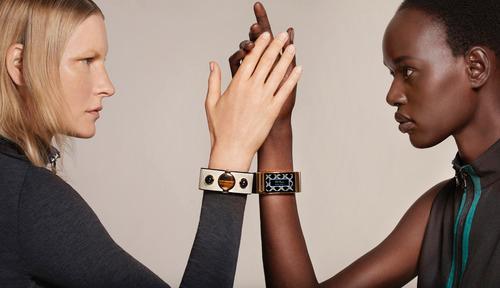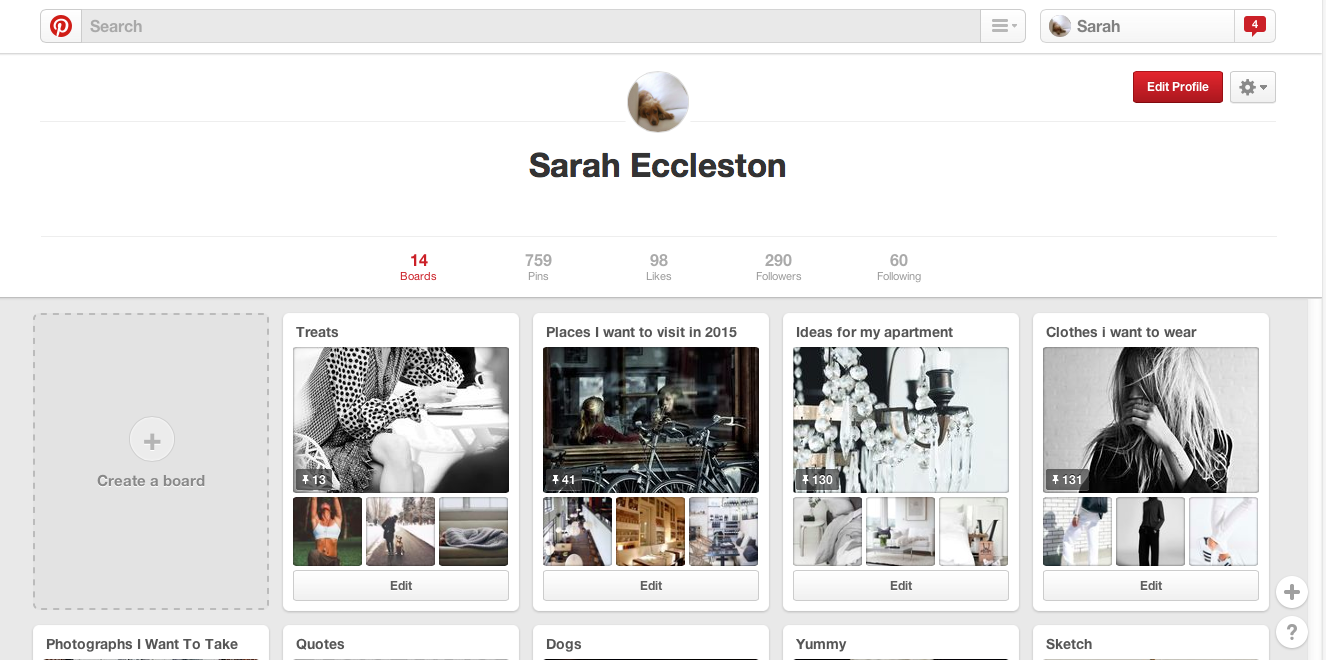
Wear Your Heart (and your computer) On Your Sleeve.
Good news for all the people out there with no sense of direction. At CES this year, the Navigate Jacket was launched, with shoulder pads that vibrate to tell you whether to turn left or right, and double tap when you arrive at your destination. (I’m not making this up. Google it).
Welcome to Wearables, one of the more recent trends in the field of IT and proof of the coming together of fashion and technology. We may be easily fooled, for example, that the picture below is a fashion ad:-
But no. It’s an ad for the MICA – an Intel Smart Bracelet that tells you when you are late for a meeting. Still think that Apple is a technology company? Yes, so do I. Except in the last 24 months, Apple have hired Angela Ahrendts from Burberry, Paul Deneve from Yves Saint Laurent, and designer Marc Newson in order to understand the demands of fashion branding, and the Apple iWatch made appearances at Paris Fashion Week where it was worn by Karl Lagerfeld. So the lines are getting blurred.
And it’s leading to big business.
News of a gold Apple iWatch that may retail for as much as $10,000 is reported, Wearables stole the show at CES this year, and this weekend, the FT reported Morgan Stanley’s predictions for the growth in wearables, which is as many as 0.5Billion shipments a year by 2020.
So, what does this mean for the Cisco Network?
Well, first, it’s the Cisco Internet of Everything that will allow us to realize some of the main benefits of Wearables. This is because when we connect ‘things’ to the internet, they can ‘talk’ to each other. So in a world where all ‘things’ can talk to each other, the traffic light can ‘tell’ your car to brake because it’s red, a cow can ‘tell’ the farmer it’s ready for milking and your fridge can ‘tell’ your local supermarket it’s low on strawberry yoghurt.
Same with wearables. When an elderly patient is wearing an internet-connected t-shirt, that t-shirt can sense and ‘tell’ the internet when the elderly person has fallen. Because the ambulances are also connected to the internet, with a Cisco 819 router, the ambulance and 999 services can immediately be ‘told’ that a patient has fallen and the fall can be attended to immediately, rather than when the next visit from a care assistant is due.
Similarly, when a prisoner is given a pre-release home visit, they can be given an internet-connected t-shirt for location tracking. If the prisoner attempts escape by removing or giving the t-shirt to someone else to wear, the t-shirt can ‘tell’ the prison guard services that the biometric data has changed.
- Your watch can ‘tell’ your doctor your state of fitness, your Smart socks can ‘tell’ your personal trainer your running patterns, and your wristband can ‘tell’ your Smart TV when you have fallen asleep so it records the rest of the film you were watching before you nodded off (I’m not making that up either – Google Kipstr).
Wearables and the Internet of Everything also mean that by wearing internet-connected clothing, we become sensors in our environment. MIT recently developed something called the Copenhagen Wheel, which when attached to your bicycle, provides feedback on pollution, congestion, weather and road conditions in real time. There is absolutely no reason why our internet-connected baseball caps, or jackets, or shoes, can’t act as environmental sensors in the exact same way.
Imagine every internet-connected t-shirt is a red dot on a map, advising local governments of current and potential crowds enabling better crown management in cities, stadiums and tourist areas. This is precisely what we currently provide with our Cisco CMX technology, where every red dot is a Wi-Fi device… it can be just as easily done with internet-connected shirts.
So the Internet of Everything is enabling wearables to be not just “gimmicks”, or extensions of our smartphones, but actually to provide benefits to citizens, by allowing these wearables to talk to each other and to other ‘things’.
What’s so great about the Cisco network specifically though, is that it’s not just the same internet it always was. We’ve made it even more intelligent, in order to sustain and enable some of these new trends and applications of the internet. Let’s look at some of the things we have done.
First, we developed and added something called Data In Motion to our network technology. This is a technology using Deep Packet Inspection (DPI) which enables the Cisco network to inspect and review the data being sent, and to make a decision to only send the data which is interesting. Why is this valuable? Consider some of the use cases above. If your watch is constantly (and in networking terms that means every millisecond or more) sending the data about your health to your doctor, and your wristband is constantly telling your TV you are still awake and watching, and the elderly patient’s t-shirt is constantly telling the internet that they have NOT fallen down, that’s a lot of data, and it’s mostly useless. The costs of backhauling that data would make IoE and Big Data price-prohibitive. So instead, with Cisco Data in Motion, the Cisco network is able to assess what data is ‘interesting’ and useful – i.e., when it changes and/or when something ‘happens’, and transmit that data. The Cisco network knows it can discard the rest.
By doing this, Cisco has reduced the amount of data backhauling by 1000x.
Second, we have made developments in something called Fog Computing – a way of analyzing and computing data closer to the edge, rather than backhauled all the way to the cloud for analysis. Again, using an example above, if I am riding that Copenhagen bicycle wheel in West London, and I therefore have data about the traffic conditions in West London, I don’t really want to send that data all the way to a Data Centre in East London (or often, much further) for analysis. I want it to be processed quickly (and more cheaply) by analyzing the data locally. Fog Computing enables this.
Cisco have developed Fog Computing solutions in a number of ways – two notable ones are the CGR Ruggedised router which has an onboard SD Card for onboard analytics – literally enabling analytics to be performed in the cabinet in the street – and the Cisco ISR Router with a UCS in it, enabling the same thing in a local branch rather than backhauling data to a Cisco UCS server in the Data Centre for analysis.
Third, consider that with wearables, much of the data we produce is out of date almost immediately. When I am running around the park (actually, I did make that one up. If you ever see me running, call the police) my location information is useful and interesting information to a platform which is tracking my route. But it is out of date before it can get sent to a database or analysed.
So, in 2012, Cisco purchased Truviso, and with it the capability to continuously analyse such streams of high volume data. It’s easy to see why Wearables – depending on their application – could be the source of this kind of always-on real-time data.
I don’t want to end a piece about internet connected clothes, without finally discussing how the IoE and wearables will change the way we purchase clothes. Last week I was giving a speech on how technology will affect the future of shopping at Harvey Nichols. So – I stood in Harvey Nichols, with my iPad connected to the Harvey Nichols Wi-Fi, logged in to Pinterest, on which I have a folder called “Clothes I Want to Wear”; containing pins of clothing items I would like to buy. (I know this is sounding too nerdy to be true, so here is a screenshot of my Pinterest page just to prove it):-
Yet, despite this fact, and despite the fact that Harvey Nichols sell many of those very same clothing items, they weren’t advising me they were available, in my size, on the 2nd and 3rd floors of the store, as I stood there, iPad in hand, on the 5th. . We’re missing a trick, no?
But with the Internet of Everything and Wearables, we won’t miss that trick. Harvey Nichols will (with my consent) know what clothes I wear, what clothes hang in my closet, more importantly what clothes I want which are NOT hanging in my closet, my favourite brands and the prices I usually pay for my clothing items. They will not only be able to tell me that the clothes I want are in store in my size, they will be able to tell me the clothes I want that I don’t even know I want yet.
I can hardly wait.
Tags:
1 Comments







Re: “… If you ever see me running, call the police”.
Presumably, that wouldn’t be necessary because your internet connected wearables would ‘tell’ the internet on detecting this out of character behaviour and because the police are also connected to the internet, they would immediately be ‘told’ that you are running and, therefore, must be in danger and so would attend immediately.